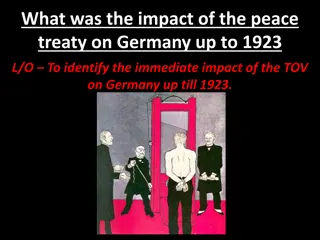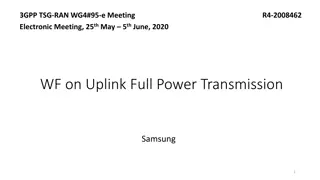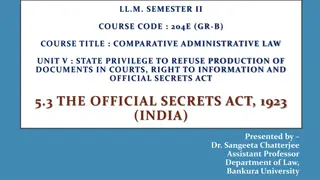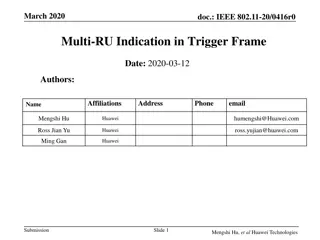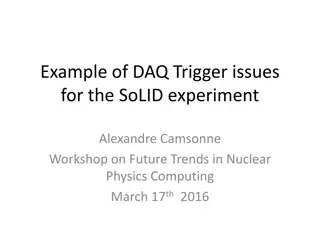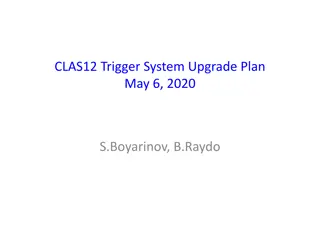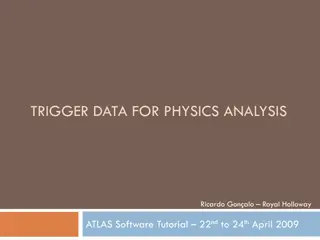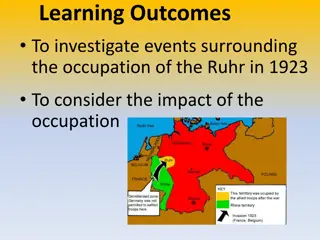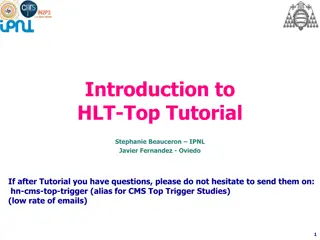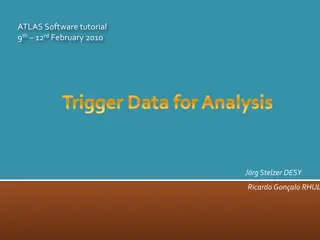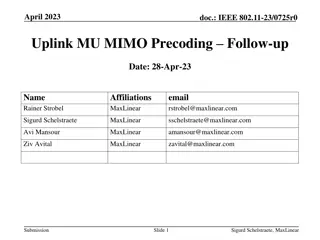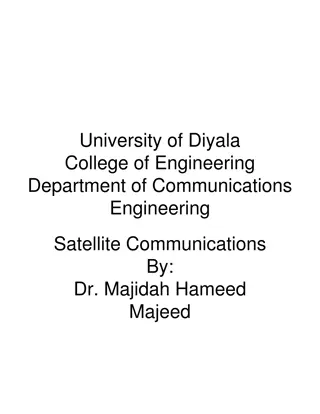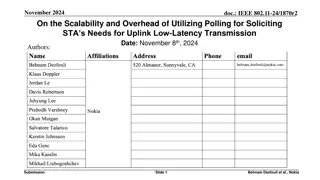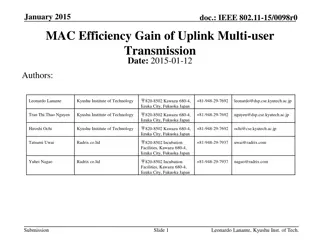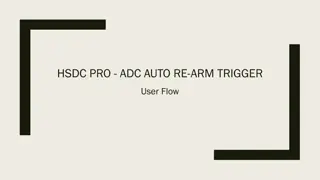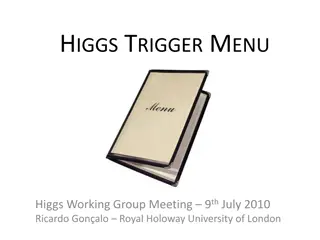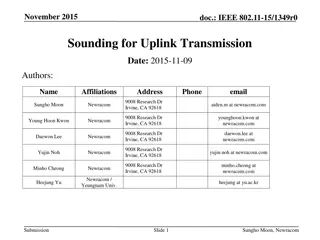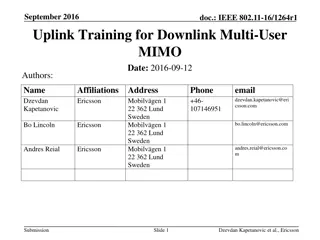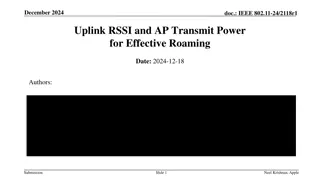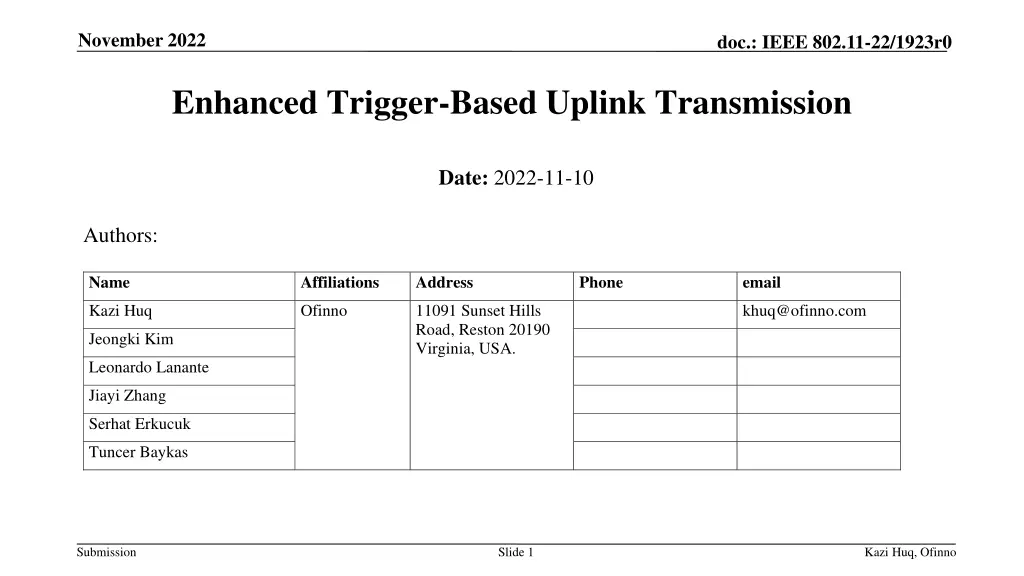
Enhanced Trigger-Based Uplink Transmission for Ultra High Reliability
Explore the enhanced trigger-based transmission approach for Ultra High Reliability (UHR) to reduce latency and improve system efficiency in IEEE 802.11 networks. Learn how this solution enhances uplink transmission to achieve low latency goals for UHR applications, increasing reliability and reducing overhead.
Download Presentation

Please find below an Image/Link to download the presentation.
The content on the website is provided AS IS for your information and personal use only. It may not be sold, licensed, or shared on other websites without obtaining consent from the author. If you encounter any issues during the download, it is possible that the publisher has removed the file from their server.
You are allowed to download the files provided on this website for personal or commercial use, subject to the condition that they are used lawfully. All files are the property of their respective owners.
The content on the website is provided AS IS for your information and personal use only. It may not be sold, licensed, or shared on other websites without obtaining consent from the author.
E N D
Presentation Transcript
November 2022 doc.: IEEE 802.11-22/1923r0 Enhanced Trigger-Based Uplink Transmission Date: 2022-11-10 Authors: Name Affiliations Address Phone email Kazi Huq Ofinno 11091 Sunset Hills Road, Reston 20190 Virginia, USA. khuq@ofinno.com Jeongki Kim Leonardo Lanante Jiayi Zhang Serhat Erkucuk Tuncer Baykas Submission Slide 1 Kazi Huq, Ofinno
November 2022 doc.: IEEE 802.11-22/1923r0 Abstract This contribution discusses enhanced trigger-based transmission for UHR. Reducing latency is one of the major goals for UHR. Enhancing the trigger-based solution for uplink transmission may help to achieve the low latency goal for UHR Submission Slide 2 Kazi Huq, Ofinno
November 2022 doc.: IEEE 802.11-22/1923r0 Introduction UHR [1] passed to form the Ultra High Reliability (UHR) study group (SG) to develop PAR for the beyond be 802.11 WLAN. The major emphasis of the Next-Gen WLAN will be on [1] Improve reliability Reduce latencies Increase manageability Increase throughput, including at different SNR levels Reduce device-level power consumption Several contributions regarding low latency are already presented in UHR SG [2]-[4]. During the WNG session in July 2022 plenary meeting, a motion was Submission Slide 3 Kazi Huq, Ofinno
November 2022 doc.: IEEE 802.11-22/1923r0 Trigger-Frame rules in IEEE 802.11 A trigger frame (TF) allocates resources for and solicits one or more TB PPDU transmissions. The TF also carries other information required by the responding STA to send a TB PPDU. TF is needed to signal the non-AP STAs to begin UL transmission of their data with their assigned resource units (RU)s. An AP sends a TF to initiate UL MIMO operation using UL OFDMA or UL MU-MIMO transmissions. The TF identifies non-AP-STAs participating in UL MU operation and assigns RUs and/or spatial streams to these STAs. TXOP Multi-STA BlockAck Trigger Frame SIFS SIFS AP TB PPDU STA 1 TB PPDU STA 2 Submission Slide 4 Kazi Huq, Ofinno
November 2022 doc.: IEEE 802.11-22/1923r0 Multiple Uplink Transmissions in a TXOP In existing standard (802.11 ax/be architecture) in a TXOP Needs multiple TFs to allocate resources for initial transmission and transmission afterward. Granting multiple uplink transmissions is based on transmitting multiple TFs. It increases overhead due to multiple trigger frame transmission in uplink. TXOP Multi-STA BlockAck SIFS Trigger Frame Trigger Frame SIFS BA SIFS SIFS SIFS AP TB PPDU TB PPDU STA 1 TB PPDU STA 2 Slide 5 Submission Kazi Huq, Ofinno
November 2022 doc.: IEEE 802.11-22/1923r0 Enhanced Trigger-based Transmission (1) We propose to allocate multiple UL transmissions using a single TF. It will improve system efficiency in terms of latency. For example, One TF carries the information for the STAs to have multiple UL transmissions. Removal of multiple TFs and SIFSs reduces latency. Reliability can also be increased if the subsequent PPDU retransmits the same data. Submission Slide 6 Kazi Huq, Ofinno
November 2022 doc.: IEEE 802.11-22/1923r0 Enhanced Trigger-based Transmission (2) Option 1: Multiple UL transmission in a single TF. TXOP Multi-STA BlockAck SIFS SIFS Trigger Frame Trigger Frame SIFS BA SIFS SIFS AP TB PPDU TB PPDU STA 1 TB PPDU STA 2 Schedule STA 1 for multiple transmission Schedule STA 2 for a single transmission Remove the next TF TXOP Multi-STA BlockAck Trigger Frame SIFS BA SIFS SIFS SIFS AP TB PPDU TB PPDU STA 1 TB PPDU STA 2 Submission Slide 7 Kazi Huq, Ofinno
November 2022 doc.: IEEE 802.11-22/1923r0 Enhanced Trigger-based Transmission (3) Option 2: Multiple UL transmission with no Multi-STA BlockAck between PPDUs in a single TF TXOP Multi-STA BlockAck SIFS SIFS Trigger Frame Trigger Frame SIFS BA SIFS SIFS AP TB PPDU TB PPDU STA 1 TB PPDU STA 2 Signal STA 1 for multiple transmission Signal STA 2 for a single transmission No Multi-STA BlockAck transmission TXOP Trigger Frame SIFS BA SIFS SIFS AP TB PPDU TB PPDU STA 1 TB PPDU STA 2 Submission Slide 8 Kazi Huq, Ofinno
November 2022 doc.: IEEE 802.11-22/1923r0 Comparison of Estimated TXOP Duration Assumptions N: # of STAs =2, MCS0 (for Non-HT), MCS7 (for EHT) Bandwidth = 80 MHz Payload Size = 100 Octets, 500 Octets, 1000 Octets Tones 484 Tones for EHT TB PPDU (Data Rate = 146.3 Mb/s) Preamble Duration 20 s (Non-HT) 48 s (EHT) EHT TB PPDU Data Duration Ceiling((#Octets*8 /Data Rate) / 16) * 16 s Trigger frame duration: [{(16+9+6*N+6) Bytes * 8+16+6}/(48*1/2)]*4 s +20 s (Non-HT Preamble Duration) TB PPDU duration: 48 s (EHT Preamble Duration) + EHT TB PPDU Data Duration Multi-STA BA frame duration [6] : Ceiling[{(22+12N)*8+16+6}/(48*1/2)]*4 s+ 20 s (Non-HT Preamble Duration) BA frame Duration [6]: Ceiling{(32*8+16+6)/(48*1/2)}*4 s+ 20 s (Non-HT Preamble Duration) SIFS = 16 s Type 100 Octets 500 Octets 1000 Octets Duration ( s) Duration ( s) Duration ( s) Gain compared to the existing trigger-based transmission Gain compared to the existing trigger-based transmission Gain compared to the existing trigger-based transmission Existing Trigger-based Transmission 502 546 600 Enhanced Trigger-based Transmission (Option 1) 405 19.3 % 449 17.8 % 503 16.2 % Enhanced Trigger-based Transmission (Option 2) 304 39.4 % 348 36.3 % 402 33 % Submission Slide 9 Kazi Huq, Ofinno
November 2022 doc.: IEEE 802.11-22/1923r0 Summary We discussed the potential enhanced trigger-based transmission for UL transmission to meet the low latency target of UHR. We envision that enhanced trigger-based transmission has the potential to reduce latency. Submission Slide 10 Kazi Huq, Ofinno
November 2022 doc.: IEEE 802.11-22/1923r0 Straw Poll Do you think that trigger-based transmission in the baseline specs (ax/be) may be modified to improve latency in UHR SG/TG? Yes: No: Abstain: Submission Slide 11 Kazi Huq, Ofinno
November 2022 doc.: IEEE 802.11-22/1923r0 References [1] E. Jeon et al., Beamforming Improvement for UHR, https://mentor.ieee.org/802.11/dcn/22/11-22-1392- 00-0uhr-beamforming-improvement-for-uhr.pptx. [2] W. B. Lee et al., Latency Reduction Scheme for UHR, https://mentor.ieee.org/802.11/dcn/22/11-22- 1393-00-0uhr-latency-reduction-scheme-for-uhr.pptx. [3] T. Shu, Requirements of Low Latency in UHR, https://mentor.ieee.org/802.11/dcn/22/11-22-1519-00- 0uhr-requirements-of-low-latency-in-uhr.pptx. [4] L. Lu, Multi-AP Coordination for Low latency Traffic Delivery, https://mentor.ieee.org/802.11/dcn/22/11-22-1519-00-0uhr-requirements-of-low-latency-in-uhr.pptx [5] Draft IEEE Standard for Information Technology Telecommunications and Information Exchange between Systems - Local and Metropolitan Area Networks Specific Requirements - Part 11: Wireless LAN Medium Access Control (MAC) and Physical Layer (PHY) Specifications, IEEE P802.11- REVme/D2.0, pp. 1 5797. [6] J. Kim et al., A Method of transmitting Multi-STA Block ACK, https://mentor.ieee.org/802.11/dcn/15/11-15-1330-00-00ax-a-method-of-transmitting-multi-sta-block- frame.pptx Submission Slide 12 Kazi Huq, Ofinno

